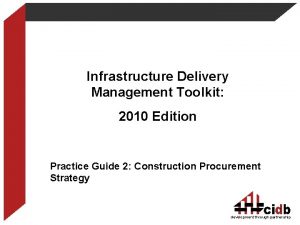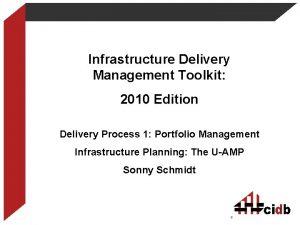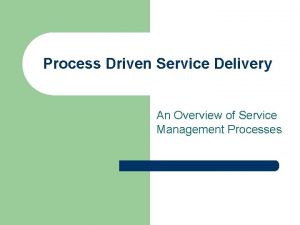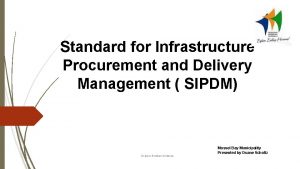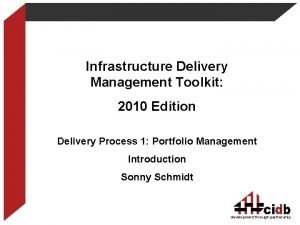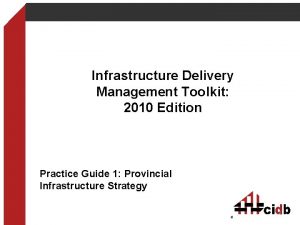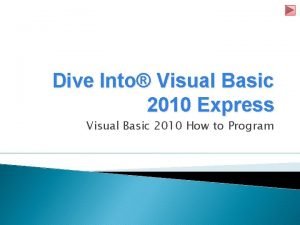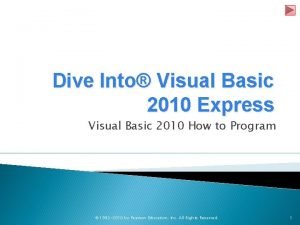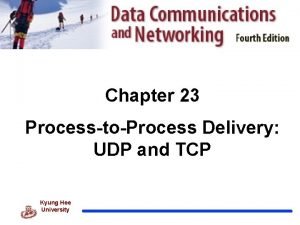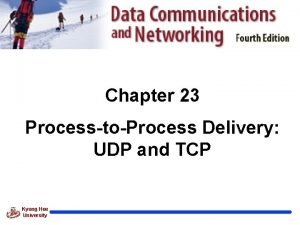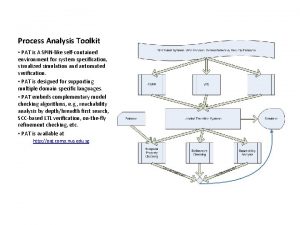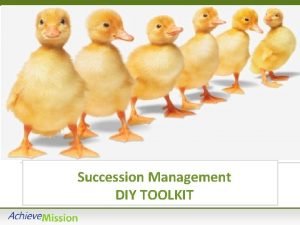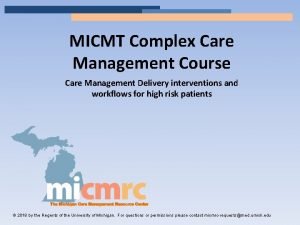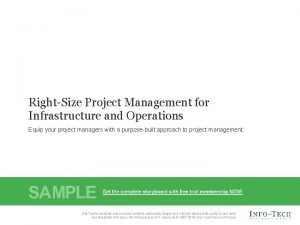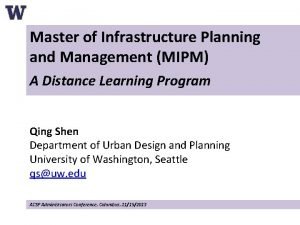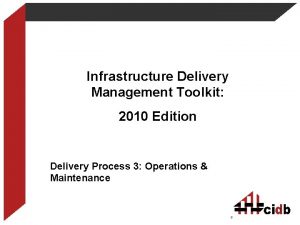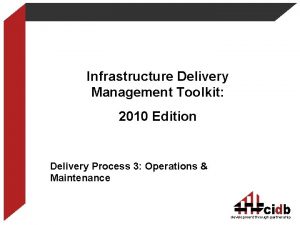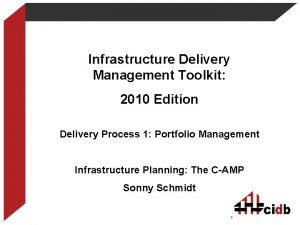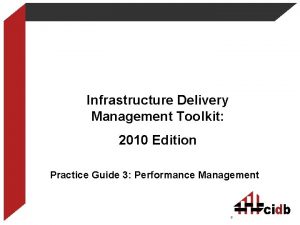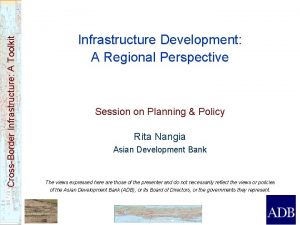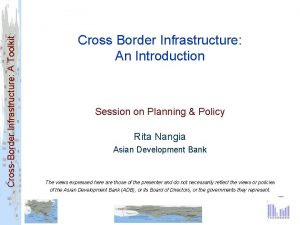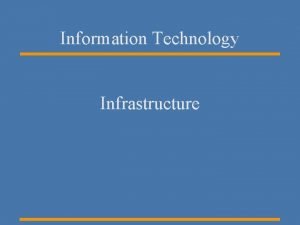Infrastructure Delivery Management Toolkit 2010 Edition Delivery Process



















- Slides: 19

Infrastructure Delivery Management Toolkit: 2010 Edition Delivery Process 1: Portfolio Management Infrastructure Planning: The U-AMP Sonny Schmidt 1 development through partnership

The IDMS Prov Infr Strat DP 1: Portfolio Management DP 1 -1 Infrastructure Planning Develop U-AMP Develop C-AMP (including prioritised (including work plans) MTEF works list) DP 1 -2 Programme Management G 1(a) PF 1. 3 G 1(b) PF 1. 4 Develop/review IPMP Dev Proc Strat P C 1 PF 2. 1 G 2 PF 2. 2 PF 5 Manage Implementation PF 2. 3 PF 4 DP 2: Project Management DP 2 -1 Planning (Develop IPIP) Package definitio n Package prep P C 2 G 3 PF 1. 3 Works plannin g G 4 Design developt. P C 3 P C 4 a PF 1. 4 G 5 P C 5 MFC Info G 6(a) T 1 PF 2. 1 PF 5 DP 2 -4 Close Out DP 2 -3 Works DP 2 -2 Design Con/Del works G 6(b) P C 4 b PF 2. 2 Project Close Out Handovr works G 7 Update Asset Register G 8 T 2 PF 2. 3 PF 4 DP 3: Operations & Maintenance DP 3 -1 Recognise & accept assets G 8 PF 1. 3 DP 3 -2 Mobilisation for Facilities Mgt PF 1. 4 DP 3 -3 Operations PF 2. 1 PF 5 DP 3 -4 Maintenance PF 2. 2 PF 2. 3 DP 3 -5 Demobilise Facilities Mgt PF 3 PF 4

User and Custodian Portfolio Management Outputs User organisations Custodian organisations U-AMP Construction procurement strategy IPMP Organisation and Support plan Monitoring reports Recommended actions C-AMP Work Plans Organisation and Support plan Monitoring reports Recommended actions 3



Infrastructure Planning Methodology 6

Basic 3 Gaps to be determined: • Space Gaps • Utilisation Gaps • Functional Gaps • Condition Gaps • Efficiency Gaps Other Gaps: • Capacity gaps • Funding Gaps

Project Cost Estimating & Budgeting SCOA: Category of Expenditure: – Capital: • • Acquisition (new, additions) Upgrading, Alterations, Conversions Renovation, Refurbishment (Rehabilitation) Disposal – Current: • Routine maintenance • Staff, systems Based on Life Cycle Costing 8

Life Cycle Costing (1) • All costs (estimated & actual) over the life cycle of an asset are taken into consideration in order to make future decisions about the asset. • Includes: – capital e. g. initial acquisition cost and future upgrades, – rehabilitations – operations and maintenance 9

Life Cycle Costing (2) 10

Estimate for new infrastructure asset 11

Portfolio Budget build up 12

“Programme View” of Budget 13

The Need for Budget Revision Project Budget – The “Control” Budget? Financial Year Budget: Demand for work exceeds available fund: – Re-schedule work – Apply robust Prioritisation Criteria – Document prioritisation decisions 14

Budget Revision due to Progressive Improvement of Cost Estimates Cost estimating through the Project Life Cost Estimate Name Gateway Process stage Conceptual Infrastructure Planning Pre-feasibility Package Preparation Preliminary (Feasibility) Design Development Tender Design Documentation Definitive Works Final Close Out 15

Alignment of Budget and Infrastructure Planning Cycles (1) • Expenditure characterised by spike (hockey stick!) • Resulting in: – Roll over of funds – Over expenditure – Value not achieved – Incorrect services procured • Cabinet approved framework (2007) – Allows for due process to take place 16

Alignment of Infrastructure Planning and Budgeting (1) 17

Summary: Infrastructure Planning • User: § § § U-AMP (G 1 a) Consider service delivery mandate Infrastructure required (“Gaps”) Life cycle costs Collaboration with custodian 18

Thank you 19
 Infrastructure delivery management
Infrastructure delivery management Infrastructure delivery management toolkit
Infrastructure delivery management toolkit Infrastructure delivery management toolkit
Infrastructure delivery management toolkit Service delivery process in it infrastructure
Service delivery process in it infrastructure Sipdm
Sipdm Infrastructure delivery management system
Infrastructure delivery management system Infrastructure delivery management system
Infrastructure delivery management system Visual basic 2010 express
Visual basic 2010 express Visual 2010 express
Visual 2010 express Mis chapter 6
Mis chapter 6 Report
Report What is process to process delivery
What is process to process delivery Process-to-process delivery
Process-to-process delivery Process analysis toolkit
Process analysis toolkit Talent management toolkit
Talent management toolkit Micmt
Micmt Enemy corner seating arrangement
Enemy corner seating arrangement Businesses that accenture delivery suite(ads) support
Businesses that accenture delivery suite(ads) support It infrastructure project management best practices
It infrastructure project management best practices Masters in infrastructure planning and management
Masters in infrastructure planning and management
